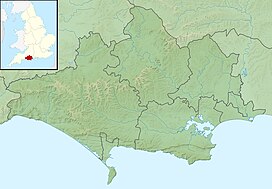Hambledon Hill
| Hambledon Hill | |
|---|---|

Child Okeford and Hambledon Hill seen from west
|
|
| Highest point | |
| Elevation | 192 m (630 ft) |
| Prominence | 140 |
| Parent peak | Win Green |
| Listing | HuMP |
| Coordinates | 50°54′45″N 2°13′19″W / 50.91250°N 2.22194°WCoordinates: 50°54′45″N 2°13′19″W / 50.91250°N 2.22194°W |
| Geography | |
| Location | North Dorset, Dorset, England, UK |
| Parent range | Cranborne Chase |
| OS grid | ST845126 |
| Topo map | OS Landranger 194 |
| Geology | |
| Age of rock | Cretaceous |
| Climbing | |
| Easiest route | Walk |
Hambledon Hill is a prehistoric hill fort in Dorset, England, situated in the Blackmore Vale five miles northwest of Blandford Forum. The hill itself is a chalk outcrop, on the southwestern corner of Cranborne Chase, separated from the Dorset Downs by the River Stour. It is owned by the National Trust.
Its earliest occupation was in the Neolithic when a pair of causewayed enclosures were dug at the top of the hill, one smaller than the other. They were linked by a bank and ditch running northwest–southeast. Two long barrows, one 68 m (223 ft) in length, also stood within the complex and a third enclosure is now known to underlie later earthworks. In all, the area of activity covered more than 1 km2 (0.39 sq mi).
Excavations in the 1970s and 1980s by Roger Mercer produced large quantities of Neolithic material. Environmental analysis indicated the site was occupied whilst the area was still wooded with forest clearances coming later, in the Bronze Age. The charcoal recovered seems to have come from timber lacing within the Neolithic earthworks.
Radiocarbon analysis gives a date of 2850 BC. At least one skeleton, of a young man killed by an arrow was found, seemingly connected with the burning of the timber defences and suggesting at least one phase of violence. A single grape pip and a leaf fragment is evidence of vine cultivation and the occupants seem to have traded with sites further to the southwest.
The ditches of the enclosures also contained significant quantities of pottery as well as red deer antler picks used to excavate them. Human skulls had been placed right at the bottom of one of the enclosure ditches possibly as a dedicatory or ancestral offering. Animal bone analysis suggests that most of the meat was consumed in late summer and early autumn, possibly indicating seasonal use of the site. Different material was found in different areas of the site suggesting that Hambledon Hill was divided up into zones of activity. The original interpretation was that the large causewayed enclosure was used as a mortuary enclosure for the ritual disposal of the dead and veneration of the ancestors with attendant feasting and social contact taking place in the smaller enclosure.
...
Wikipedia

